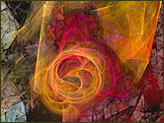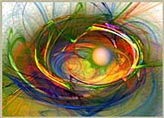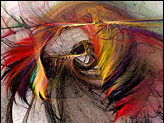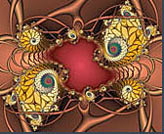|
|
 |
|
|
|
Gary Singh
Into the Abstract
About the Cover
4 November/December 2005 Published by the IEEE Computer Society
0272-1716/05/$20.00 © 2005 IEEE
|
|
After leaving school in 1965, German-based artist Karin Kuhlmann studied photography and graphic design.
She earned a living for the next 25 years as a commercial artist in the analog world of the advertising industry. “Any kind of designing, painting, and illustrating has always been part of my job,”
Kuhlmann explained. “But my creativity was strictly restricted by the respective product and the particular demands of customers and consumers. In 1994 the computer made its arrival into my life. First I
needed it for my job, but I discovered very soon the creative potential of this new artistic tool.”
In 2000 she launched her own Web site and the rest is history. “From the feedback I’ve received, I
know that a great deal of my visitors are pupils, students, and teachers from all over the world, and I get a lot of inquiries for help and information because they have to work on homework, essays,
lectures, term papers, or dissertations about computer graphics or a digital artist. Some of my works were selected to illustrate the chapters about new art, new media, hypermedia communication,
mathematics, and fractals in several educational programs and schoolbooks.”
|
|
 Symbiose Symbiose
Kuhlmann defines symbiosis as “a very close form of nationalization between two dissimilar natures, useful and necessary for both and leading to a permanent
legal partnership.” She says that Symbiose (the cover image) is an attempt to describe a lifelong partnership between two human beings like a man and a wife. “I
used two different forms to realize this idea. The one in the background shows geometrical figures like triangles, overlapping polygons, and straight clear
lines. The second form is round and fluid; the predominant colors are reds and yellows. The two forms are blended together without a visibly dividing line between
them. The cool, objective colors and forms of the background are blended with the warm, vibrant colors and forms of the foreground.” She generated the image’s main
elements with KPT5 Frax Flame, a set of Photoshop plug-ins. “Although I’ve saved hundreds of presets and my own settings for color scheme and rendering methods to
get started with, the generating of flames is only a first step. This first step may be by chance but with the choice of some structures and patterns, I already had a real
idea of the subject I would like to illustrate.”
|
|
 Symbiose, along with Meltingpot (see Figure 1) and The Huntress (see Figure 2) belong to a series of
abstract expressionistic works Kuhlmann has been working on since 2000. She said Meltingpot is a metaphor for societies with a great variety of cultural,
religious, and political minorities and their integration. The Huntress, she explained, is a very female interpretation of women’s rights, liberation, and power,
and won the online Museum of Computer Art’s 2003 Donnie Award for the Symbiose, along with Meltingpot (see Figure 1) and The Huntress (see Figure 2) belong to a series of
abstract expressionistic works Kuhlmann has been working on since 2000. She said Meltingpot is a metaphor for societies with a great variety of cultural,
religious, and political minorities and their integration. The Huntress, she explained, is a very female interpretation of women’s rights, liberation, and power,
and won the online Museum of Computer Art’s 2003 Donnie Award for the category of Fractal and Mathematical Art. When viewing Kuhlmann’s abstract expressionist images, you immediately wonder what
Jackson Pollock would have done if he had had access to a fractal generator. category of Fractal and Mathematical Art. When viewing Kuhlmann’s abstract expressionist images, you immediately wonder what
Jackson Pollock would have done if he had had access to a fractal generator.
Automatism
Art Deco2 (see Figure 3) is one example of Kuhlmann’s
more traditional fractal images, but that doesn’t mean there aren’t some psychological underpinnings going on. When asked if her creative process is one of
improvisation or calculated planning, Kuhlmann brings up the surrealists and their processes of automatism, that is, a form of automatic writing driven by the unconscious. This is how she releases her inner
pictures. She cites surrealist Max Ernst: “… the lack of a picture on an empty sheet can only be forced by developing a mechanism of poetical inspiration.”
Without hesitation, she also quotes expressionist Paul Klee: writing driven by the unconscious. This is how she releases her inner
pictures. She cites surrealist Max Ernst: “… the lack of a picture on an empty sheet can only be forced by developing a mechanism of poetical inspiration.”
Without hesitation, she also quotes expressionist Paul Klee:
“Art doesn’t reflect the visible. Art makes visible.” When working with such techniques, she begins by
generating organic shapes with KPT5 and then endlessly reworks layers, colors, light, and transparencies. “Drawing by algorithm depends widely
on coincidence,” she explained. “However, the generating and selecting of dynamic organic forms, their editing and coloring, depends on the abilities and the imagination
of the artist. Mathematical art is, although it seems to be a contradiction in terms, a very intuitive and individual kind of work.”
Ever since she began using computers as artistic tools, Kuhlmann has meandered toward the abstract and the mathematical, which is reflected in her work. “Like
music, fractals are very abstract and a wonderful medium to play with,” she said. “Dipping into the fractal space means to enter absolutely new and unknown
territories … and I’m the conqueror. Although its creation is bounded to strict mathematical rules, the results are always very inspiring … because I’m the one who
chooses the forms, the details, and the colors of each fractal - also an expression of myself.”
|
|
The future
Kuhlmann has spent her entire life in the North Rhine Westfalia region of Germany, a
place where most people aren’t familiar with computer art. Since her Web site went up 5 years ago, the amount of contacts she’s acquired through being online has led to several exhibitions and awards.
And although she’s recognized around the globe, she says she still can’t live off of her art. “I hope it will increase in the near future,” she explained, “when museums, galleries, and art lovers may
realize that we, the digital artists, are the pioneers of a new kind of contemporary art.” Kuhlmann also occasionally collaborates with artists from other disciplines. Currently, she is working on a
series titled, Music. “I got the idea for this topic in November 2004 when I was invited to have a solo exhibition together with the opera singer Monica Kopec in Krakow, Poland. Accompanied by electronic
music she tried to interpret my images shown on big screens … or vice versa: Her singing was illustrated by the images. It would be great to repeat such a music/art event because they complement one
another in a wonderful way.” Kuhlmann will also take part in an exhibition next spring titled, Electric Paint: The Computer as 21st Century Canvas, which opens at the Leigh Yawkey Woodson Art Museum in
Wausau, Wisconsin, before touring the US. “
Concerning the future,” she said, “I’m now 57. But unlike others who began to think about retiring in this age I’m full of power and ideas for new works
and projects that I’ll try to realize during the next years.”
© Alle Original Bilder (Werke der Digital Kunst) und Texte dieser Website unterliegen dem Urheberrecht. Ohne
ausdrückliche Erlaubnis der Künstlerin Karin Kuhlmann dürfen sie weder heruntergeladen, gespeichert und weiterbearbeitet, noch in irgendeiner Form für andere Websites oder Drucke jedweder Form verwendet
werden. Lesen Sie hierzu bitte auch die Copyright und Nutzungsbedingungen.
Text Autor: Karin Kuhlmann
|
|
|